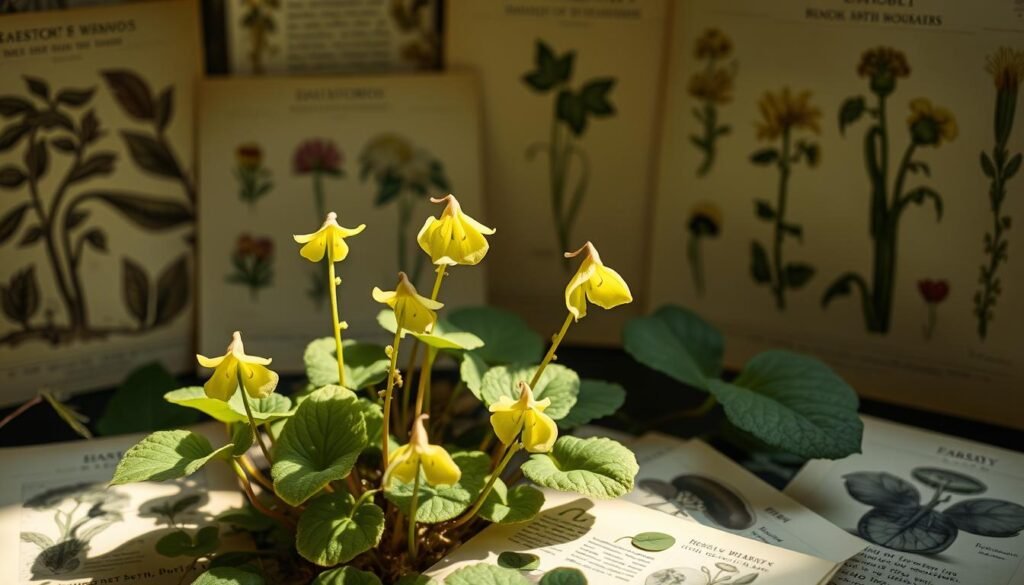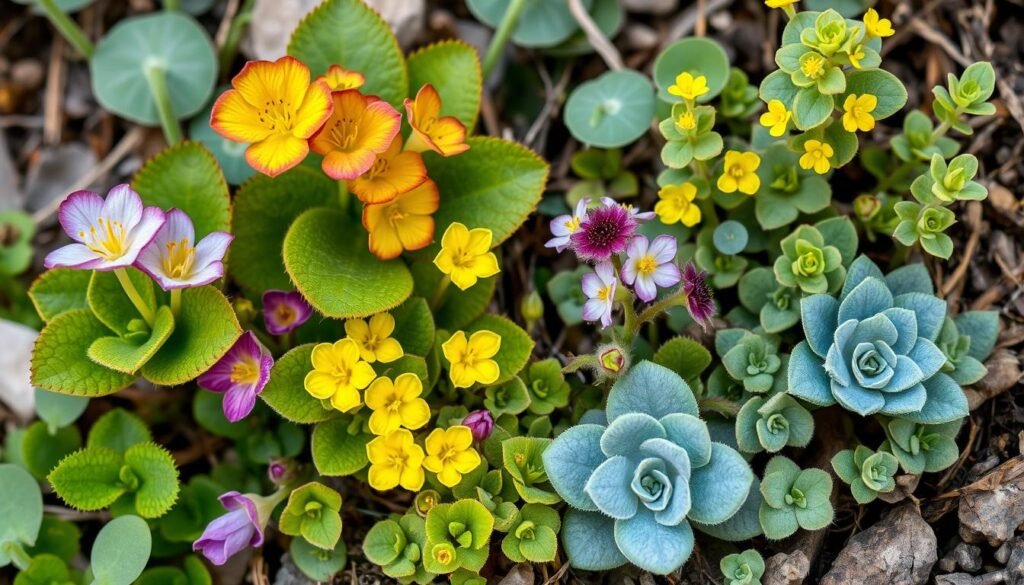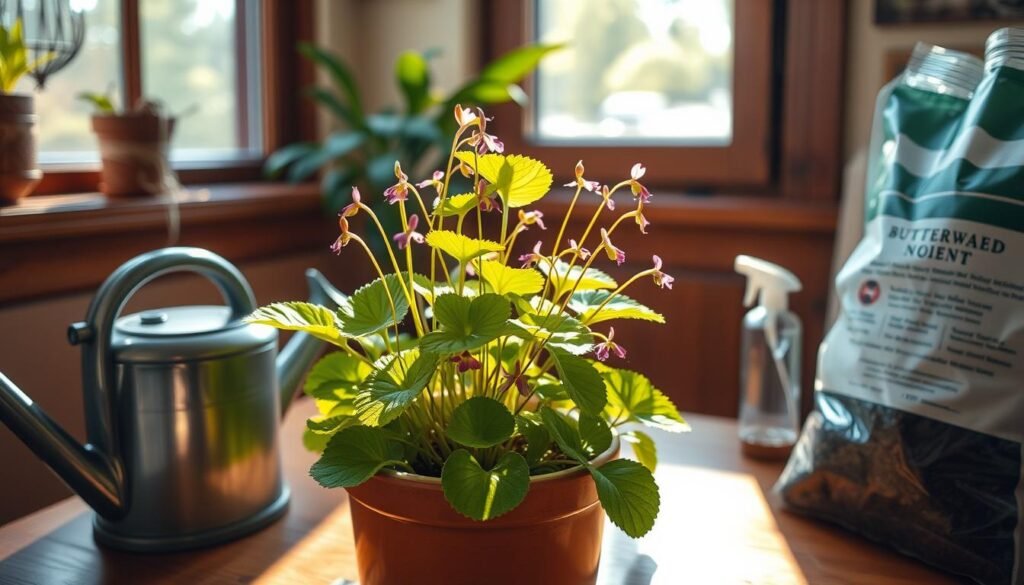The butterwort plant is a fascinating member of the Pinguicula genus. It captivates plant lovers and collectors with its unique traits and care needs. With over 80 species found across continents, butterworts are adaptable carnivorous plants. This guide will help you care for them, ensuring they thrive and display their beautiful foliage and flowers.
This guide provides key information on growing butterworts. It covers their history, varieties, care, propagation, and common issues. By learning these details, you’ll be ready to grow successful butterwort plants at home or in your garden.
Table of Contents
What is the Butterwort Plant?
The butterwort plant, known as Pinguicula, has unique features that make it interesting. It has over 80 species found on every continent except Australia and Antarctica. Its leaves are sticky, helping it catch insects.
Overview of Pinguicula
Pinguicula vulgaris, or common butterwort, grows up to 8 inches tall. It blooms in white, purple, and violet from April to August. Found from Alaska to New York, it loves bogs and moist limestone areas.
Characteristics of Butterworts
Butterworts are known for their carnivorous plant characteristics. Their leaves have sticky hairs that trap insects. The plant then digests them with special enzymes.
These plants are not only interesting but also beautiful. They have unique leaves and colorful blooms. Below is a table showing some key traits of Pinguicula vulgaris:
| Characteristic | Description |
|---|---|
| Height | Up to 8 inches |
| Bloom Colors | White, purple, violet |
| Bloom Period | April to August |
| Native Habitat | Bogs, moist limestone soil, wet rocks |
| Soil Preference | Alkaline, pH greater than 7.2 |
| Tolerance | Obligate Wetland plant (OBL) |
History and Origin of Butterworts
Butterworts, part of the genus Pinguicula, have a captivating butterwort history. Their unique adaptation and role in the ecosystem are fascinating. Learning about their evolution helps us understand the broader evolution of carnivorous plants. It shows how these plants adapted to survive in poor nutrient environments.
Evolution of the Butterwort Plant
The evolution of butterworts is centered on surviving in tough habitats. They adapted to lack of nutrients by developing sticky leaves. These leaves help them catch insects, which is key for their growth and survival.
With about 80 known species, butterworts show a wide range of adaptations. Those from South and Central America have unique growth patterns and leaf shapes.
Cultural Significance and Uses
Butterworts have been important in cultures for a long time. They are known for their antibacterial properties. Traditional medicine used them to treat wounds because of their healing abilities.
In Scandinavian folklore, butterwort leaves were used to ferment milk. This shows their value in different cultures, beyond their role in nature.

| Region | Species Count |
|---|---|
| Europe | 13 |
| North America | 9 |
| South & Central America | Largest concentration |
| Northern Asia | Some species |
Learning about the butterwort history and its cultural importance is rewarding. You can learn more about growing them through essential guides. These guides will help you have a successful butterwort experience.
Butterwort Plant Varieties
Exploring the different butterwort species reveals their unique traits and care needs. They fall into two main groups: Mexican butterworts and temperate butterworts. Each group has special adaptations for its native habitat.
Mexican Butterworts
Mexican butterworts love the warm weather of Mexico and Central America. They are known for their bright leaves and delicate growth. But, they are quite sensitive and need specific conditions like:
- High humidity levels
- Bright, indirect light
- Warm temperatures
These needs make caring for Mexican butterworts a bit tricky. They appeal mostly to serious plant lovers. Their environment is key to their colorful leaves growing well.
Temperate Butterworts
Temperate butterworts prefer cooler climates, found in North America, Europe, and parts of Asia. They handle seasonal changes well and can sleep through winter. Some key traits include:
- Robust growth habits
- Ability to thrive in various soil types
- Resistance to cold temperatures
These butterworts are good at catching nutrients from pollen. Their simple roots help them stay strong in different conditions.

| Variety | Native Range | Characteristics |
|---|---|---|
| Mexican Butterworts | Mexico, Central America | Colorful foliage, requires high humidity, sensitive to conditions |
| Temperate Butterworts | North America, Europe, Asia | Robust growth, tolerant of seasonal changes, enters dormancy |
Basic Care for Butterwort Plants
Caring for butterwort plants means knowing their light, water, and soil needs. Good care helps them grow well and stay healthy. Let’s look at these key points.
Light Requirements
Butterworts need the right light to grow. They do best in bright, indirect sunlight or artificial light. Morning sun and dappled light later in the day are perfect.
If it’s too dark, use strong fluorescent lights. Place them 12 inches above the plant. The right light makes them grow strong and their leaves bright.
Watering Your Butterwort
Watering is key to keeping butterworts healthy. Use only pure water like rainwater, distilled, or reverse osmosis. This prevents minerals from building up.
Keep the soil a bit moist. Let the top dry out before watering again to avoid root rot. Water from the top to keep the roots moist but not wet.
Soil Composition and Drainage
Butterworts need a light, draining soil mix. Mix one part sphagnum peat with two parts perlite. Don’t use regular potting soil or fertilizers.
They do best in poor soil. Change the soil every year to keep it good and prevent minerals from harming them.

| Care Aspect | Details |
|---|---|
| Light | Bright indirect sunlight or 40-watt fluorescent lights; direct morning sun preferred |
| Watering | Use pure water; keep soil slightly moist, allowing drying between waterings |
| Soil | One part sphagnum peat, two parts perlite; avoid potting soil |
Growing Conditions for Butterworts
To keep Butterworts healthy, it’s important to get their growing conditions right. This includes the right temperature and humidity levels. By understanding and managing these, your Butterworts will thrive.
Temperature Preferences
Butterworts like different temperatures based on where they come from. They do best in temperatures between 70°F and 80°F when they’re growing. Some tropical types can handle summer heat up to 100°F.
But in winter, they can handle cooler temperatures, from 45°F to 75°F. Knowing these temperature ranges is key to growing them well, even when moving them between seasons.
Humidity Levels
Humidity is also key for Butterworts. They need a humid environment, with humidity levels between 50% and 80%. You can use humidity trays or terrariums to keep the air moist.
In dry places, it’s important to keep the humidity high. This helps them grow well.

| Origin | Temperature Range | Humidity Level |
|---|---|---|
| Tropical Butterworts | 75°F – 100°F (Summer) 45°F – 75°F (Winter) | 50% – 80% |
| Temperate Butterworts | 70°F – 80°F (Growing Season) 50°F (Dormancy) | 50% – 80% |
By managing these core conditions, you can create a great environment for your Butterworts. This ensures they stay healthy and vibrant all year round.
Propagation Methods for Butterwort Plants
Propagating butterworts is a rewarding hobby for those who love carnivorous plants. There are several ways to do it, each with its own benefits. You can use seeds, leaf pullings, or offsets division to grow new plants.
From Seeds
To start with seeds, use a potting mix that drains well. Keep the seeds moist and humid for germination. Some butterworts can pollinate themselves, while others need help.
Seeds usually sprout in about a month. This is a fun way to grow more plants.
Using Leaf Pullings
Leaf pullings are another way to grow butterworts. Choose healthy leaves from a mature plant. Then, gently pull them and plant them in a growing medium.
Winter is the best time for this method. Summer leaves can grow more plantlets. After 1 to 2 months, you’ll see small plants ready for regular soil.
Offsets and Division
Offsets, or gemmae, grow at the plant’s base during dormancy. You can separate and pot them as new plants. This works well for flat-leafed pinguiculas after they flower.
Division is also a good method for some species. It’s a fast way to propagate butterworts.
| Propagation Method | Optimal Conditions | Success Rate |
|---|---|---|
| Seeds | Temperature: 20-25°C (68-77°F), Humidity: 80% | Germination in approximately 1 month |
| Leaf Pullings | Best in winter and spring | Average success of around 110% |
| Offsets | During dormancy | High propagation efficiency |
For more tips on growing butterworts, check out this guide. Learning these techniques will help you grow a thriving collection. With the right care, you’ll have beautiful, healthy plants.
Butterwort Plant Feeding
Feeding butterworts is key for their health and growth. These plants love insects, which they catch with sticky leaves. This diet helps them get nutrients they can’t find in soil.
Natural Feeding Habits
Butterworts catch insects with their leaves. This way, they get the nutrients they need. The leaves digest the insects, giving the plants the nutrients they require.
Supplemental Feeding Techniques
At times, butterworts might not get enough insects. In such cases, you need to feed them extra. You can use freeze-dried bloodworms, Betta pellets, or live daphnia. Make sure the insects are the right size for your plants.
Other options include fat-free milk and ground-up local insects. For a DIY approach, warm insects in the oven and then grind them. This can be cheaper than buying freeze-dried food.
For fertilizers, mix insect dust with soluble fertilizers. Use about 80ppm fertilizer strength. More feeding tips for carnivorous plants can help you care for them better.
| Type of Food | Feeding Method | Notes |
|---|---|---|
| Freeze-dried bloodworms | Sprinkle on leaves | High in protein |
| Betta pellets | Soak and break into pieces | Suitable for fast feeding |
| Live daphnia | Place one per leaf | Best for active feeding |
| Local insects (powdered) | Mix with soil or water | Cost-effective alternative |
By watching your butterworts and using these feeding methods, they will thrive. Keep an eye on their nutrient needs and adjust your feeding as needed for their best health.
Pests and Diseases Affecting Butterworts
Keeping your butterwort plants healthy means watching out for pests and diseases. Knowing about common pests and diseases helps you manage them better.
Common Pests
Butterworts are beautiful but can get sick from pests. Here are some common ones:
- Aphids: These pests show up in spring and can harm leaves and traps.
- Mealybugs: They suck plant juices and can spread fast, needing quick action.
- Scale insects: They live in groups and leave behind sweet droppings that attract mold.
- Spider mites: They make tiny holes in leaves and need constant treatment.
- Thrips: These pests leave streaks on leaves and might need several treatments to get rid of.
Preventing Disease
To stop diseases in Pinguicula, manage their environment well. Keep humidity, water quality, and light right. Here’s how:
- Don’t over-water, as it invites fungal infections.
- Make sure there’s good air flow around the plants.
- Take out dead leaves to keep the plant healthy.
Managing pests in carnivorous plants like butterworts works with the right care and watching. Regular checks catch problems early, keeping your plants healthy and bright.
Common Problems in Butterwort Cultivation
Caring for Butterwort plants can be tricky. You might face several common issues that can harm your plant’s health. It’s important to know the stress indicators to catch problems early.
Signs of Stress in Your Butterwort
Look out for wilting leaves, browning edges, and slow growth. These signs can mean wrong watering, not enough light, or bad temperatures. Spotting these signs early can help save your plant.
Solutions and Remedies
Fixing these problems often means changing how you care for your plant. Here are some solutions for carnivorous plants:
- Check soil drainage; it should be slightly sandy with 1 part peat moss, 1 part perlite, and 1 part sand.
- Adjust light to dappled to full sunlight, depending on the season.
- Change your watering to use mineral-free water.
- Take good care of your plant during winter to avoid damage from cold.
- Keep an eye out for pests, mold, or root rot, signs of too much water or bad moisture.
Fixing these common problems can be successful with the right care. For more info on Butterwort cultivation challenges, check this detailed guide.
Conclusion
Nurturing butterwort plants, also known as Pinguicula, requires understanding their specific needs. These plants do best with 4 to 6 hours of indirect light daily. They also need a temperature between 17 and 24 degrees Celsius.
Keeping the humidity between 40% and 70% is key to their health. This butterwort care summary highlights the importance of tailored care for these plants.
Using distilled, demineralized, or rainwater is essential for water quality. Repotting every one to two years with a 50% peat and 50% perlite mix is also important. This ensures the right soil for growth.
During winter, these plants grow smaller, non-sticky leaves. This is a natural part of their life cycle. It shows the need to adjust your care routine.
By following these tips, you’ll meet your plants’ needs and enhance their beauty in your garden. With careful attention, you can grow thriving butterworts. They will capture the attention of all who see them.



